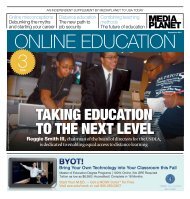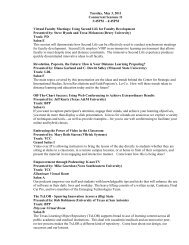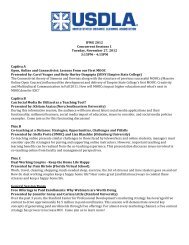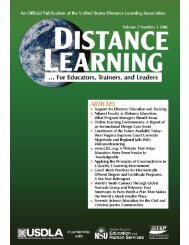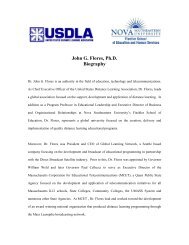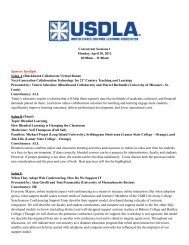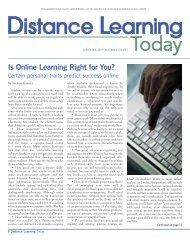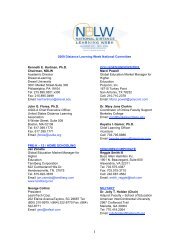United States Distance Learning Association
United States Distance Learning Association
United States Distance Learning Association
- No tags were found...
You also want an ePaper? Increase the reach of your titles
YUMPU automatically turns print PDFs into web optimized ePapers that Google loves.
Operational Definition of<br />
Building a Quality<br />
E-<strong>Learning</strong> Course<br />
and Program<br />
Abed H. Almala<br />
Many institutions of higher education,<br />
educational organizations,<br />
the business community,<br />
and learners are embracing e-learning for a<br />
variety of reasons and needs. These parties<br />
refer to key factors such as flexibility, the<br />
use of mixed interactive multimedia, Internet<br />
research, archiving, electronic networks,<br />
telecommunications, and cost to<br />
support the idea that e-learning could<br />
Abed H. Almala, Campus Dean,<br />
Alexandria Campus, Strayer University,<br />
2730 Eisenhower Ave.,<br />
Alexandria, VA 22314.<br />
Telephone: (703) 329-9601.<br />
E-mail: AAL@strayer.edu<br />
serve as a viable and qualitative learning<br />
alternative. Some educators and learners,<br />
however, believe that e-learning cannot,<br />
and should not, replace classroom instruction,<br />
pointing out that the quality of faceto-face<br />
education must not be compromised<br />
by e-learning. Nevertheless, professional<br />
and scholastic individuals with such<br />
reservations often recognize that e-learning<br />
can be a valuable supplement and<br />
effective learning tool for mature and<br />
responsible students and should be pursued.<br />
Hence, quality of learning is a deciding<br />
factor as to whether e-learning should<br />
be considered as a total and effective learning<br />
environment.<br />
Recent educational statistics and forecasts<br />
have revealed that e-learning is gaining<br />
ground in community colleges and<br />
universities nationwide. Investigating and<br />
assessing the planning and implementation<br />
processes of e-learning courses and<br />
programs at these institutions of higher<br />
education is necessary to determine the<br />
quality of a Web-based learning environment.<br />
Quality e-learning is a Web-based<br />
learning environment designed, developed,<br />
and delivered based on several<br />
dynamic principles, such as institutionalsupport,<br />
course development, teaching/<br />
learning, course structure, student support,<br />
faculty support, and evaluation and<br />
assessment (Phipps & Merisotis, 2000).<br />
16 <strong>Distance</strong> <strong>Learning</strong> Volume 4, Issue 4



